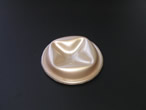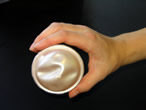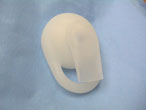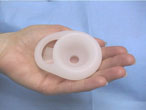 PRODUCT UPDATES PRODUCT UPDATES
As we reported in the September 2014 newsletter, discontinuation was planned for both the latex Reflexions Diaphragm and the Lea Contraceptivum silicone barrier. We can confirm that both lines are no longer being produced. Additional details follow below.
Reflexions Flat Spring Diaphragm
We have received confirmation that Williams Medical is discontinuing the Reflexions Flat Spring Diaphragm. Produced in Britain in a range of sizes, from 55 mm to 95 mm, this latex diaphragm had a rim that was similar to a coil spring but was thinner and more delicate. Product stock will not be replenished beyond what is currently available.
 
Lea Contraceptivum
Biovision, the manufacturer of the Lea Contraceptivum silicone barrier, has ended its production following a failure of their manufacturing equipment. Available only in Germany, the Lea Contraceptivum had been offered in a single size and was approved for up to 48 hours of continuous use. We are not aware of plans for production elsewhere.
 
VOTE: Woman's Condom named finalist for the Readers' Choice Medical Design Excellence Awards. Voting ends on Wednesday, June 3, at 5:00 p.m. EST
The Woman's Condom is a finalist in the Over-the-Counter and Self-Care Products category of the Medical Design Excellence Awards (MDEA), the Medtech Industry's Premier Awards Program. This contest seeks to identify the highest-caliber medical devices on the market today and celebrates the achievements of medical product manufacturers, their suppliers, and the many people behind the scenes.
Vote for the Woman's Condom now!
PATH, CONRAD, and local research partners developed the Woman's Condom with input from women and men in several countries. This process resulted in unique design features that promote ease of use and comfort for both partners.
Here's how to vote and spread the word:
- Follow this link to the Readers' Choice MDEA voting page.
- Select the Woman's Condom and click "done". It's that easy! You can also click on each finalist to learn more about the various products.
- Share the Readers' Choice MDEA link on your Facebook wall and invite your friends to vote. Voting ends on Wednesday, June 3, at 5:00 p.m. EST so please act quickly!
For more information about the Woman's Condom, visit the PATH website.
 FEATURED RESEARCH FEATURED RESEARCH
The following are recently completed and upcoming research studies on topics related to cervical barrier methods and female condoms.
Recently completed research:
Contraceptive effectiveness and safety study of the SILCS diaphragm: The pivotal study
Contraceptive effectiveness study
Location: United States
In 1994, PATH, an international nonprofit organization based in Seattle, began development of a single-size silicone contraceptive diaphragm, incorporating input from users and clinicians to identify and address issues that have limited the use of currently available diaphragms. The SILCS diaphragm was developed based on user evaluations in multiple sites in the US. Additional testing was performed in South Africa, Thailand, and the Dominican Republic to confirm user acceptance. Results of the CONRAD Phase I postcoital study found the single-size SILCS diaphragm used with nonoxynol-9 during intercourse was comparable to a traditional diaphragm and prevented progressively motile sperm from reaching cervical mucus (Schwartz et al. 2008). Results of a study using magnetic resonance imaging to evaluate the fit of the SILCS in vivo indicate that the device fits women of varying parities and body sizes (Yang et al. 2007).
CONRAD then evaluated the SILCS diaphragm in a contraceptive effectiveness, safety, and acceptability study implemented at six centers in the US. The study recruited 450 couples who used the single-size diaphragm with a contraceptive gel as their primary contraceptive method for six months. Three hundred women used the single-size diaphragm with BufferGel (an investigational new drug that was being developed at that time as a contraceptive gel and also as a microbicide to potentially protect from STIs, including HIV). The remaining 150 women used the single-size diaphragm with Gynol II (a contraceptive gel that contains nonoxynol-9). This study was designed to be similar to another recent study of a traditional diaphragm used with BufferGel (Barnhart et al. 2007) so the study results could be compared.
Results from this study confirmed that the single-size diaphragm fits most women and performs similarly to a traditional diaphragm.
The clinical portion of the study was complete as of November 2009. Results from this study were submitted to the US FDA in 2012, and will support a regulatory application for the SILCS diaphragm.
The abstract for this study is below.
Schwartz JL, Weiner DH, Lai JJ, Frezieres RG, Creinin MD, Archer DF, et al. Contraceptive efficacy, safety, fit, and acceptability of a single-size diaphragm developed with end-user input. Obstet Gynecol 2015;125(4):895-903.
OBJECTIVE: To estimate contraceptive efficacy, safety, acceptability, and fit of a single-size diaphragm used with contraceptive gel. METHODS: We conducted a multicenter trial in which 450 couples used the single-size diaphragm, 300 randomized to acid-buffering gel and 150 to nonoxynol-9, for at least 190 days and six menstrual cycles. Visits were at enrollment and after menstrual cycles one, three, and six. Study outcomes included pregnancy probability, safety, acceptability, and fit. Pregnancy and safety were compared with an historical control group who used a standard diaphragm with these gels. RESULTS: Most (439/450 [98%]) women could be fitted with the single-size diaphragm. A total of 421 of 450 (94%) provided follow-up. The 35 study pregnancies yielded six-month Kaplan-Meier cumulative typical use pregnancy probabilities per 100 women with 95% confidence intervals (CIs) of 10.4 (6.9-14.0) for all users and 9.6 (5.5-13.6) and 12.5 (5.4-19.5) with acid-buffering gel and nonoxynol-9, respectively. Historical control analysis yielded a propensity score-adjusted estimate of this pregnancy probability for the single-size diaphragm of 11.3 compared with 10.7 per 100 women for the standard diaphragm ([rounded] difference 0.7, 95% CI -3.6 to 4.9). Approximately half (51%) reported at least one urogenital event but compared favorably to the standard diaphragm in historical control analysis. Most (282/342 [82%]) liked the diaphragm. Results suggest that if provided by a clinician, 94% (95% CI 92-96%) could insert, correctly position, and remove the diaphragm. CONCLUSION: The single-size diaphragm was safe, as effective as a standard diaphragm, and acceptable when used with contraceptive gel.
This study was sponsored and conducted by CONRAD, and funded by USAID.
Potential distribution channels for the Woman's Condom in China
Market assessment study
Location: Multiple sites across nine provinces in China
Female condoms are a new product in China. They are not currently included in the national family planning program or HIV prevention programs, and few women or men have seen or heard of female condoms. Female condoms have been evaluated primarily in studies focused on sex workers. To explore public and commercial sector opportunities for the Woman's Condom in China, research partners have implemented five market tests to assess uptake and acceptability of the Woman's Condom across different market segments in nine provinces in China. These included: 1) unmarried youth/factory workers at Marie Stopes International (MSI) clinics in three cities, with MSI; 2) married couples/general population at family planning centers in Beijing (urban) and 10 villages in Guangdong (rural), with the China Population and Development Research Center and China Contraceptive Supplies Administration; 3) married couples/general population at family planning centers in three cities, with the Shanghai Institute of Planned Parenthood Research; 4) female sex workers in three cities, with the Beijing Union Medical College; and 5) HIV discordant couples in Sichuan and Hunan provinces, with the National AIDS Control Center (NCAIDS).
The methodology for each market assessment was developed by the local research partner in consultation with PATH. In all studies participants were asked to report on use over several months.
The Woman's Condom was well accepted by women/couples across all target groups, with 58%-89% of the participants across the market tests expressing willingness to continue use, and 10% reporting liking it very much. The MSI market study generated particular interest by the family planning stakeholders, since the MSI clinic reaches target groups not well covered by government clinics. The NCAIDS study showed that including the Woman's Condom into outreach services for sero-discordant couples helped increase levels of protected sex and reduced the reported levels of forced sex. Health providers and family planning managerial staff at various levels were positive about introducing this new contraceptive method. Results from the market tests were shared with family planning and HIV stakeholders and provincial and district-level decision makers at two stakeholder meetings in late 2014.
|
Upcoming research:
Phase I safety study of the SILCS diaphragm used with Contragel
Randomized, parallel double-blind phase I study
Location: United States
The purpose of this study is to determine systemic and genitourinary safety of Contragel used with the SILCS diaphragm vs. the HEC Universal Placebo gel used with the SILCS diaphragm during two seven-day periods of daily use, the first without intercourse and the second with intercourse.
This single-center randomized, parallel double-blind phase I study will be conducted in 24 healthy premenopausal women protected from pregnancy. Participants will be randomized in a 1:1 ratio to insert the SILCS diaphragm used with either Contragel or the HEC Universal Placebo gel every day for two seven-day periods in two separate menstrual cycles.
The protocol is in development. The start date is anticipated in the third quarter of 2015, depending on ethics approval from the relevant IRB. The study is scheduled to be completed by July/August 2016.
This study will be implemented by CONRAD at the Eastern Virginia Medical School. The study is funded by USAID.
A randomized crossover trial of the functional performance, safety, and acceptability of the Origami Internal Condom
Randomized crossover study
Location: South Africa
The Origami Internal Condom is a new condom that has been designed to be used for either anal or vaginal sexual intercourse. This randomized comparative crossover trial will evaluate functional performance, safety, and acceptability of the Origami Internal Condom compared to FC2. The study will enroll 28 couples (14 heterosexual for vaginal use and 14 homosexual for anal use) agreeing to use five each of the two condom types.
The fieldwork will commence in mid-2015.
The study is funded by the Bill and Melinda Gates Foundation via Origami Healthcare Products, and will be implemented by MatCH Research.
Introduction of new female condom products: Lessons from dual programming in South Africa
Market assessment
Location: South Africa
In recent years, the development of new female condom products has become a reality and several female condoms are in various stages of regulatory approval. Although this has the potential to widen choice and lower product costs, there are other considerations that need to be addressed. New products vary considerably in design, material, and method of insertion and once available, providers and users will need to be trained on the use of new female condoms. Until 2013, only the FC2 female condom was available in South Africa. In 2014, Cupid and the Pleasuremore female condoms were introduced into some public and non-public sector sites in South Africa.
This project is in the planning phase and will assess the introduction of new female condom products in South Africa through interviews with providers and clients, commencing in mid-2015.
The study is funded by the Universal Access to Female Condoms Joint Programme (UAFC), and will be implemented by MatCH Research.
|
RESOURCES
Updated bibliographies:
At the links below you can view and download bibliographies of published peer-reviewed research on female condoms, diaphragms, and cervical caps. We strive to keep these resources up-to-date and have included research published through May 01, 2015. If you discover that relevant research is absent from this list, please let us know.
Female condom bibliography
Diaphragm and cervical cap bibliography
Recent publications:
The following are recent published abstracts on topics related to cervical barrier methods and female condoms (January 2015 to present).
Female condoms
- Beksinska M, Smit J, Greener R, Piaggio G, Joanis C. The female condom learning curve: Patterns of female condom failure over 20 uses. Contraception 2015;91(1):85-90.
- Cavalcante LD, Oliveira GO, Almeida PC, Reboucas CB, Pagliuca LM. Assistive technology for visually impaired women for use of the female condom: A validation study. Rev Esc Enferm USP 2015;49(1):14-21.
- Mahlalela NB, & Maharaj P. Factors facilitating and inhibiting the use of female condoms among female university students in Durban, KwaZulu-Natal, South Africa. Eur J Contracept Reprod Health Care 2015;(0):1-8 [Epub ahead of print].
- Mvundura M, Nundy N, Kilbourne-Brook M, Coffey PS. Estimating the hypothetical dual health impact and cost-effectiveness of the Woman's Condom in selected sub-Saharan African countries. Int J Womens Health 2015;7:271-7.
- Ventura-DiPersia C, Rodriguez K, Kelvin EA. Failure of many United States department of health websites to provide accurate information about the female condom. Contraception 2015 [Epub ahead of print].
- Wang X, Xi M, Zhang L, Jia L, Wang Y, Cheng Y. Awareness of female condoms and failures reported with two different types in China. Int J Gynaecol Obstet 2015;128(2):152-6.
- Weeks MR, Zhan W, Li J, Hilario H, Abbott M, Medina Z. Female condom use and adoption among men and women in a general low-income urban US population. AIDS Behav 2015 [Epub ahead of print].
Diaphragms/caps
- Gollub EL, Cyrus E, Devieux JG, Jean-Gilles M, Neptune S, Pelletier V, et al. 'Men don't need to know everything': A field trial of a discreet, female-initiated, contraceptive barrier method (FemCap) among Haitian-American women. Cult Health Sex 2015:1-17.
- Schwartz JL, Weiner DH, Lai JJ, Frezieres RG, Creinin MD, Archer DF, et al. Contraceptive efficacy, safety, fit, and acceptability of a single-size diaphragm developed with end-user input. Obstet Gynecol 2015;125(4):895-903.
|

